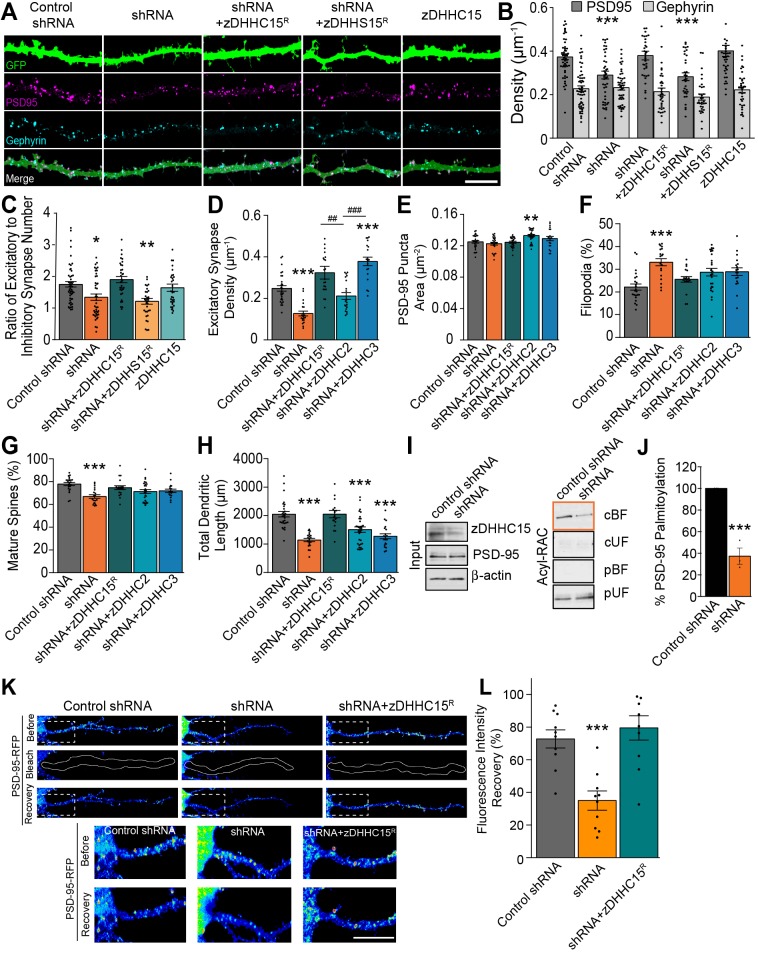Fig. 4.
zDHHC15 knockdown decreases excitatory synapse density in hippocampal neurons and disrupts PSD-95 trafficking into dendrites. (A) Representative confocal images of rat hippocampal neurons at 13 DIV expressing eGFP plus the indicated constructs. Control shRNA is a scrambled form of the shRNA targeting zDHHC15 (zDHHC15 shRNA, shortened to shRNA) to ensure there are no off-target effects of the shRNA. zDHHC15R is a form of zDHHC15 that has had mutations introduced to modify the sequence recognized by the targeting shRNA to make it shRNA resistant. zDHHS15R is a construct wherein the catalytic cysteine has been modified to serine to reduce palmitoylation activity and is also resistant to the targeting shRNA. Immunostaining was for the excitatory post-synaptic marker, PSD-95 and the inhibitory post-synaptic marker gephyrin (masked as per Fig. S2E). Scale bar: 10 µm. (B) The density of PSD-95-positive puncta is significantly decreased in zDHHC15 knockdown neurons, while the density of gephyrin-positive puncta remains unchanged. (C) This alters the ratio of excitatory:inhibitory synapse density being formed onto zDHHC15 mutant neurons. n=51 (control), 43 (shRNA), 33 (shRNA+zDHHC15), 34 (shRNA+zDHHS15), 33 (zDHHC15) neurons, three cultures. (D) The zDHHC15 shRNA-mediated reduction in excitatory synapse density (density of colocalized PSD-95 and excitatory pre-synaptic marker VGlut1 puncta) is rescued by coexpression of zDHHC15, zDHHC2 or zDHHC3. (E) The area of PSD-95 puncta is unchanged in cells expressing zDHHC15 shRNA but significantly increased compared to controls in cells expressing zDHHC15 shRNA plus zDHHC2. (F,G) zDHHC15, zDHHC2 and zDHHC3 rescue zDHCH15 shRNA-mediated changes in the proportion of filopodia (F) and mature spines (G). (H) By contrast, zDHHC2 and zDHHC3 are unable to rescue zDHHC15-mediated decreases in dendritic length. n=25 neurons, three cultures. (I) Acyl-RAC assay from cultured neurons at 7 DIV that were nucleofected with control or zDHHC15 shRNA. Left panel (input levels): zDHHC15 was reduced by 66.25±6% in neurons that had been transfected with zDHHC15 shRNA, reflecting the efficiency of transfection. No changes in PSD-95 levels were observed. Right panel (Acyl-RAC fractions): Results from the same blot; PSD-95 palmitoylation is decreased in cultures transfected with zDHHC15 shRNA (cleaved bound fraction, cBF), low levels of non-palmitoylated PSD-95 (cUF, cleaved unbound fraction), and minimal non-specific binding to the resin (pBF, preserved bound fraction). The pUF (preserved unbound fraction) represents samples that have not been cleaved. (J) PSD-95 palmitoylation is decreased in zDHHC15 knockdown neurons. n=3 cultures. ***P<0.001, Student's t-test, mean±s.e.m. (K) Hippocampal neurons at 10 DIV were transfected with the indicated constructs plus PSD-95-RFP. Puncta of PSD-95-RFP within an entire primary dendrite branch (white outline) were photobleached at 13 DIV and fluorescence recovery was analysed 9 h after bleaching. Fluorescence recovery was decreased in cells expressing zDHHC15 shRNA (PSD-95 puncta pseudo-colored for fluorescence intensity). Magnified area of interest shown below. Scale bar: 10 µm. (L) Quantification of fluorescence recovery. n=10 neurons, three cultures. ***/###P<0.001, **/##P<0.01, *P<0.05, one-way ANOVA and Tukey's post-hoc test, mean±s.e.m.

